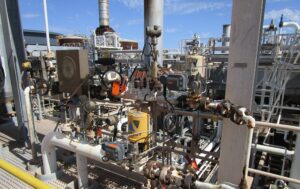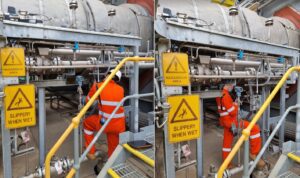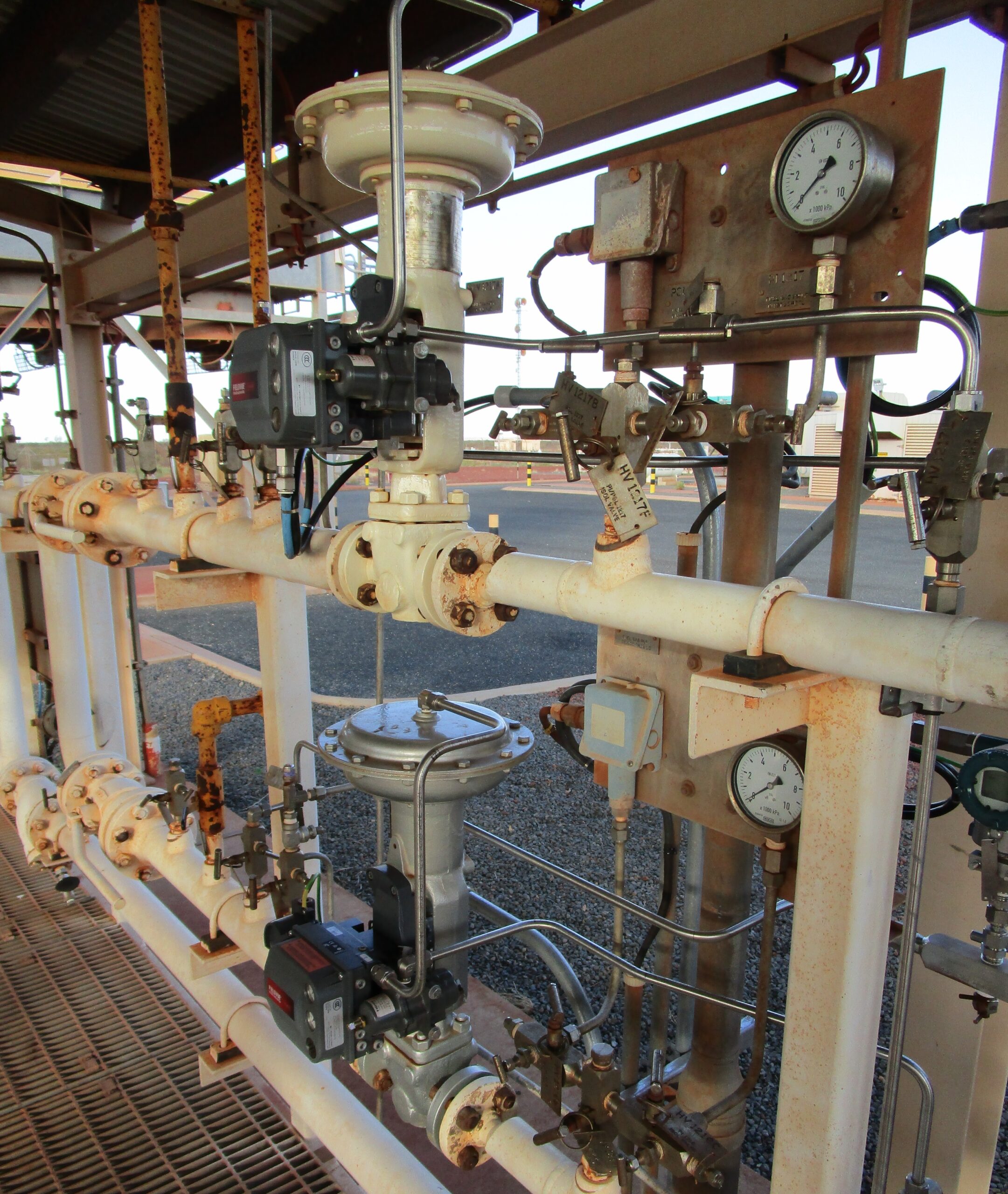What is a hazardous area?
A hazardous area is defined in AS/NZS 60079.0, as:
‘an area in which an explosive atmosphere is present, or may be expected to be present, in quantities such as to require special precautions for the construction, installation, and use of potential ignition sources’
There is the potential for an explosive or flammable atmosphere to be present where flammable or combustible materials are produced, handled or stored. In these areas, it is critical that sources of ignition, such as electrical equipment, are controlled to reduce the risk of an explosion or fire occurring.

Instrumentation on an oil and gas facility off the coast of Western Australia
The four main phases of hazardous areas management
1. Classification of hazardous area
The responsibility for classification of a hazardous area rests with the persons or parties in control of the installation (AS/NZS 3000).
Area classification should be carried out by a team of competent persons who have the appropriate knowledge of the properties of flammable materials, the process and the equipment to make informed decisions.
2. Selection of equipment
Once the hazardous area has been defined and classified, the appropriate electrical equipment can be selected for use in the hazardous area in accordance with the requirements of AS/NZS 60079 series and AS/NZS 3000 Wiring Rules.

ATEX certified equipment does not automatically comply in Australia and a Conformity Assessment Document (CAD) will be required
For explosive gas atmospheres, three major requirements are specified for equipment to be used in areas zoned 0, 1 or 2:
- The equipment complies with an appropriate explosion-protection technique for the relevant Zone in which it is to be used.
- The equipment meets the group requirements for the hazardous material(s) in which it is to be used (Group I or Group IIA, IIB or IIC).
- The equipment has an appropriate maximum surface temperature or temperature class for the hazardous material (T classification).
New equipment installed in Australia must comply with one of the following certification standards:
- IECEx
- AUSEx
- ANZEx
Foreign equipment (for example ATEX) other than those named above DO NOT automatically comply with Australian Standards and must be assessed for conformity and that assessment must be documented in the HAVD.
3. Maintenance & inspection of electrical equipment in hazardous areas
Over time, equipment can degrade or become damaged. Poor maintenance can compromise the equipment’s protection and introduce a source of ignition. Duty holders must comply with AS/NZS 60079.17 as required by State and Federal Government legislation to maintain equipment in a serviceable state.
AS/NZS 60079.17 sets out procedures for the inspection and maintenance of equipment in explosive atmospheres, to ensure that the installation undergoes appropriate inspections and is maintained in a satisfactory condition for the complete lifecycle of the equipment within the hazardous areas.

Personnel carrying out work on equipment in hazardous areas should be suitably qualified, competent and experienced in the safe management of equipment in explosive atmospheres
The standard also provides three grades of inspection (Visual, Close and Detailed) and four types of inspection (Initial, Periodic, Sample and Continuous supervision). The grade of inspection and the interval between periodic inspections should be determined by taking into account:
- Type of apparatus.
- Manufacturer’s guidelines.
- Factors governing the equipment’s deterioration (for example, environmental).
- The Zone in which the apparatus will be installed and maintained.
- Results of previous inspections (if any).
Continuous supervision by skilled personnel may be used in lieu of regular periodic inspections in line with AS/NZS 60079.17.
An inspection programme should ensure that:
- Inspections are conducted in accordance with AS/NZS 60079.17.
- Before any new electrical installation is placed into service and energised, it is given an initial detailed inspection.
- The interval between inspections for fixed equipment does not exceed four years without seeking expert advice and completing appropriate risk assessments.
- Defects identified in an inspection are rectified as soon as practicable (ignorance is not an excuse for a lack of maintenance).
- All inspection test records (ITR) should be added to the hazardous area verification dossier (HAVD).
- Visual or close grade periodic inspections should be upgraded to detailed grade inspections if major defects are found.
4. The development of a Hazardous Area Verification Dossier (HAVD)
A ‘Verification Dossier’ is defined in AS/NZS 60079.14 as
‘a set of documents showing the compliance of electrical apparatus and installations’
It is used for maintenance purposes and for the recording of:
- Test results
- Inspections
- Apparatus overhauls
- Records of repair and modification
- Changes to the area classification.
A duty holder should ensure that a verification dossier is prepared and maintained for all electrical equipment within the hazardous area and should form part of the Safety Management System and be referred to in the Gas Management Plan (if one exists). The verification dossier should be used to ensure that the electrical equipment and installation techniques used are appropriate for the areas in which the equipment is installed.
The dossier should include up-to-date information from all stages of the EEHA management process. The following documentation should be included:
- Area classification documents.
- An outline of the methods used to determine the area classification and reasoned argument for the justification of any decision that might not logically align with the relevant standards and hence prove controversial (the use of ATEX equipment needs to be justified for use in Australia as it is not automatically compliant).
- Diagrams which show zone/s, apparatus group, temperature classification and any special conditions. The diagrams should be readily available for all personnel who may be expected to carry out work in the area.
- Equipment details, e.g., temperature ratings, type of protection, IP rating, corrosion resistance.
- Records sufficient to enable the explosion-protected equipment to be maintained in accordance with its type of protection (AS/NZS 60079.14), e.g., list and location of equipment, spares, certificates, technical information and manufacturer’s instructions.
- Copies of previous inspection records (inspection schedule) including all test results, maintenance reports, any defects found, and actions taken to correct these defects.
- A statement of the identity of the person(s) having legal ownership of the installation or parts thereof and where the verification dossier is located. The HAVD is a living dossier that needs to be kept up to date.
Further considerations
Employers must provide employees with the relevant information, instruction, training and/or supervision as is necessary to perform their work safely and without risk to health. Employees who carry out design, construction, maintenance, testing and inspection of electrical installations in hazardous areas, are required to be competent.
For the purpose of hazardous areas management, a competent person is someone who can demonstrate a combination of knowledge and skills to effectively, efficiently and safely carry out activities in hazardous areas (see AS/NZS 60079.14 for more information).
AS/NZS 4761:2018 sets out the general competencies required by personnel working with electrical apparatus in hazardous areas, and the technical training required to achieve those competencies.
Conclusion
Designing, inspecting, and maintaining equipment in an explosive atmosphere requires specialist skills and competent personnel to safely and adequately comply with the Standards and obligations set out in WHS legislation.
Evidence of adequate maintenance must be kept, and equipment must be maintained correctly. Ignorance is not an excuse when human lives are at stake.
Ask us a question on LinkedIn.

